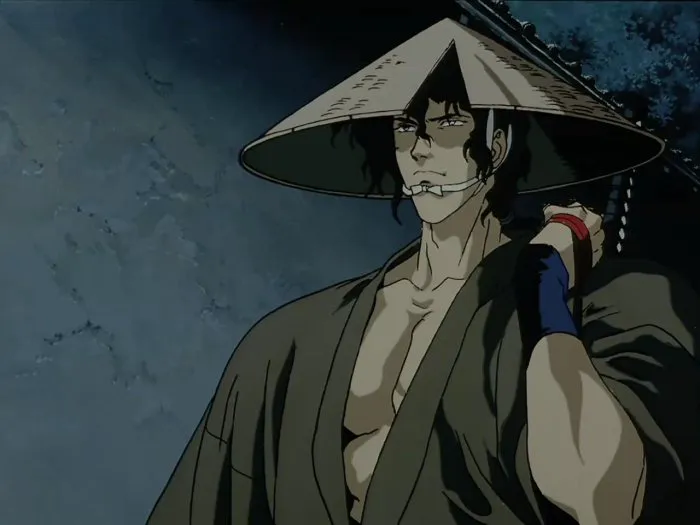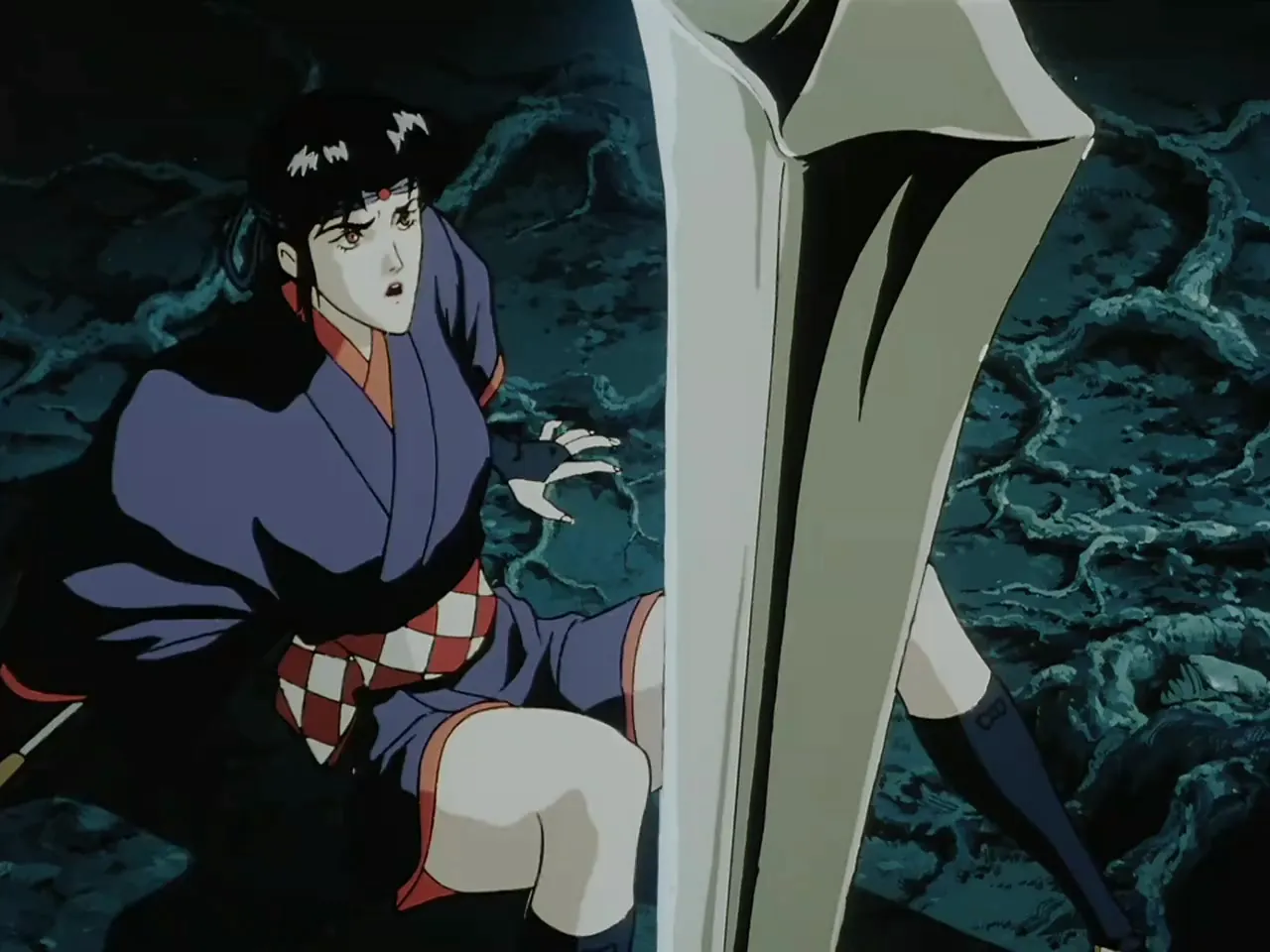Ninja Scroll: A Classic Anime Action Film
A historical fantasy action film about the confrontation of powerful ninja with superhuman talents and skills.
Set in 17th century Japan, the country is unified under the rule of the Tokugawa shogunate after a century and a half of continuous wars. However, law and order are not yet fully established. When a plague epidemic breaks out in a village near the coast, the local authorities declare a quarantine and send a ninja squad to investigate. Only one girl, Kagero, returns. The rest are killed by mysterious warriors with supernatural abilities. Kagero is rescued by Jubei Kibagami, a wandering ninja. When Dakuan, a government agent sent to study the situation, learns of this, he poisons Jubei with a slow-acting poison. He promises Jubei money and an antidote if the talented warrior finds out what the ruthless “superhumans” are doing in the village and manages to destroy them.

Historical Allusions
The name of the film’s protagonist is a reference to Mitsuyoshi Yagyu Jubei, a brilliant warrior of the first half of the 17th century. He taught three Tokugawa shoguns swordsmanship, spent 12 years traveling the country, and eventually became a character in many legends and a number of feature films and anime. In turn, Dakuan, disguised as a monk, is a reference to the Zen teacher Soho Takuan, one of the most famous sages and religious writers of the 17th century.
The Ninja Phenomenon
Espionage is an ancient military profession known throughout the world, but only in Japan has it grown into a grand pop culture phenomenon called “ninja.” Why pop culture and not historical? Because real ninja, as far as we can tell, were ordinary samurai who specialized in secret operations – primitive but effective. During the era of Japanese feudal strife, the forces of many rivals were approximately equal, and therefore accurate information about the enemy army or the poisoning of an enemy commander could bring the ninja’s employer a guaranteed victory. When the Tokugawa shoguns united the country, the need for ninja disappeared, and they vanished with it, retraining as government spies and industrial spies. The myth of the ninja, however, began to grow at the speed of an “atomic mushroom.” After all, since ninja kept their methods and operations secret, anything could be said about them, even blatant absurdities about their superhuman abilities and “special street magic.” Thus, gradually, over four centuries, the phenomenon that is now one of the main subjects of Japanese cultural export was formed.

Balancing History and Fantasy
The 1993 anime film “Ninja Scroll,” created and directed by Yoshiaki Kawajiri, balances on the edge of history and pure fiction. On the one hand, the ninja in it are not presented as abstract super-warriors, as, for example, in the famous anime series “Naruto,” but as who they really were – soldiers in the service of the government and influential clans, or wandering samurai without a master, like the protagonist Jubei.

On the other hand, even ordinary ninja in the film are endowed with superhuman jumping ability and the ability to balance on thin tree branches. The main characters are more like X-Men than ordinary Japanese. Each of them has unique abilities, and some look like mutants. For example, one character’s body is a wasp hive, and this warrior can use wasps as a weapon. And the villainous henchman who kills Kagero’s comrades at the beginning of the film can turn his body into stone, impenetrable to cold weapons. And that’s not all! There are heroes in the film with even cooler and stranger talents.
Action Over Philosophy
Why such diversity? Because conceptually, “Ninja Scroll” is the complete opposite of “Ghost in the Shell.” Unlike Mamoru Oshii, who drew his picture for the sake of philosophical dialogues, Kawajiri sought to create an inventive fantasy action film in which the diversity of characters guarantees the uniqueness and unpredictability of each battle scene. On the contrary, the conversational episodes in “Ninja Scroll” play a subordinate role. Their main tasks are to explain to the audience the nuances of a rather complex plot and to make the already bright characters more colorful. However, this does not mean that the dialogues are composed haphazardly. By the standards of the genre, they are perfect, and the character of each hero is felt from the very first lines.

A Genre Masterpiece
In general, everything in “Ninja Scroll” is so honed that it is almost impossible to find fault with it. The only thing that can be “presented” to the film is that it does not have any special, deep meaning. Ultimately, this is a film like “Kill Bill” – a magnificent, dramatic action film, but no more than an action film, and its characters are traditional genre archetypes, albeit better written than in ordinary action films, whose screenwriters often do not give the floor to many minor characters at all. In “Ninja Scroll,” even episodic characters seem like full-fledged personalities, although not too complex.

However, a genre masterpiece is still a masterpiece, and “Ninja Scroll” confirms this definition with every carefully drawn and superbly animated frame. Kawajiri’s picture and Madhouse studio impress from beginning to end – with a stylish picture, bizarre characters, unexpected plot twists, spectacular battle scenes, references to the history of Japan (the director sought to draw the attention of viewers to the past of the nation)… And a dark, but not depressing “noir” atmosphere. The latter does not allow any of the positive heroes to be ideal and guarantees the film not an implausibly rosy happy ending, but a melancholic ending in the spirit of “evil is punished, but good has nothing to celebrate,” which is more suitable for a tough movie. Thanks to all of the above, “The Manuscript” wants to be reviewed, even if you know it by heart.
A Word of Caution
However, this should only be done by adults. There is too much black humor, bloody “dismemberment” (the heroes love to chop from the shoulder!) and sexual violence in Kawajiri’s film for children (Jubei saves Kagero when one of the villains tries to abuse her). Also, given the current Russian laws, it must be indicated that one of the villains in the picture is gay, and his orientation is mentioned in almost every scene with his participation. In 1993, this was a bold move, emphasizing the extremity and uncompromising nature of Kawajiri’s anime. Now, perhaps, the film does not benefit from this. But it doesn’t suffer either. You can’t spoil porridge with butter!